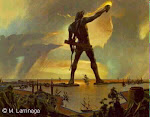I am grateful for many things, but few things more than my love of math. Don't misunderstand me when I say this for I've never been a math prodigy. Indeed, I never earned anything over a C in math between 5th Grade and 12th Grade. Interestingly enough, I earned A's in 5th Grade Math and A's in 12th Grade Calculus. Go figure. But I digress.
My high school taught me many things, and my high school teachers were responsible for 90% of those things, but it was, oddly enough, my 10th-12th Grade math teacher that taught me to love math. It took her three years to do it and I spent most of that time hating math, but when I left her, I did so with the deepest understanding of the universe and how it works as I had ever had to that point in my life.
Math is all about relationships. Xs and Ys, independent variables and dependent variables, and the relationships that exist between them. Numbers certainly are dry and unfeeling and do things that can seem rather pointless to the untrained eye. But tell somebody that musical harmony has a mathematical relationship (quadratic, I belive, but then again, I'm not a math teacher nor a music major) or that food supplies and populations share a unique relationship that can be described with a linear function and, well, if they have any interest in anything, their interest in math will be (at least) piqued.
I spent today as I spent yesterday and as I intend to spend the next week: reviewing my classes for the impending semester exam in my history class. In September, before this Blog began operating and before I had received my textbooks, I decided to teach my students social scientific methodology. Take an observed phenomenon, ask a why question about it, offer a hypothesis explaining it, test it, and find out if you were right. Repeat as required. Obviously there's more to it than that, but I'm not going to write my whole lesson right here. So, after months of indirectly using the method in class, we return to where this all began and review the method itself.
I find myself faced with the need of reviewing independent variables and dependent variables. The kids have learned some things since I first taught this, so it went better than it had in September. Using questions ranging from "Why are students failing Social Studies?" to "Why were people migrating at the beginning of the Iron Age?", we proposed hypotheses such as "Students are failing Social Studies because they aren't paying attention in class" and "People were migrating at the beginning of the Iron Age because food supplies were low."
After school today, two of my students (a Friday girl and a Thursday boy) came for a deeper review of the method. We used the question & hypothesis about the Iron Age so that we could review both the method and the Iron Age (another section on my exam) at the same time. We made up fake food supply numbers (Y) and fake population numbers (X) and we went through the numbers and, after 10 minutes of calculation, we discovered a positive linear relationship between food supply and population. But that wasn't the hypothesis! So we re-attacked the numbers, this time looking at population change from year to year, and came up with a negative linear relationship... with a y-intercept that had to be discovered! 0 = m(18), and m does not equal 0, so there has to be a b.
We didn't know slope (m) or the y-intercept (b), all we had were several points. We solved for b, then we solved for m, then we had the equation of our line! Y=-333 1/3 (x) + 6,000!
The kids loved it. They had never seen math do that before, though they had seen the beginnings of that math before in math class. Both of them immediately came to understand the deeper meaning of math... and they understood that history has math in it. They instantly got the whole purpose of the method, they realized what math is and what it does and how the thinking of math is in everything else. They got how the history could be better understood using math.
They got it. Two of my students had a breakthrough that I did not have until 12th Grade. That's what I did today. Math, history, knowledge... I have to tell you that after that experience, to quote Louis Armstrong, "I said to myself, 'What a wonderful world.'"
Cheers to math from a teacher of history. Cheers to Mrs. Savage. And cheers to anyone who ever came to understand that math describes everything.
Tuesday, January 8, 2008
Subscribe to:
Post Comments (Atom)

No comments:
Post a Comment